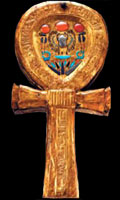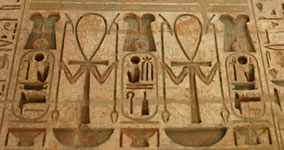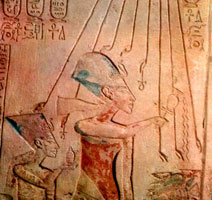
The Ankh is one of the most famous and widely used symbols of Ancient Egypt. It appeared in hieroglyphic text and iconography all over ancient Egypt. Yet, there is much debate over the origin of the symbol. Gardiner (who composed the standard sign list) suggested that it was a sandal strap. This part of the sandal was called ‘nkh but it is not clear whether this name was applied retrospectively because of the similarity in shape.

Others have suggested that it was a totem representing male and female reproductive parts, a sun on the horizon with the path of the sun before it, and a ceremonial girdle. It may also have been associated with the “Sa” (the hieroglyphic symbol that represented magical protection) and has also been linked to the Tjet (also known as the “knot of Isis”) which has also been described as a ceremonial girdle.

The symbol is also an Ancient Egyptian hieroglyph which represents the hieroglyph ´nh (ankh) meaning “life” or “breath of life”. The glyph appears in an incredible number of inscriptions and was often used as a decorative device. Many of the gods of Egypt are depicted bearing an Ankh to represent their vivacity and immortality. Occasionally, the god (or goddess) extends the Ankh to the Pharaoh, indicating both the gift of life and the purification of the subject.

During the Amarna period the sun disc, The Aten, was often depicted with small ankhs at the end of its rays which extended down to the royal family. The Ankh could also symbolise the purifying power of water. Various scenes in the temples of Upper Egypt depict the king flanked by two gods (one of whom is often Thoth) who pour a stream of little Ankhs over his head to cleanse him.

The Ankh was also associated with life after death. The dead were sometimes referred to as “ankhu”, and sarcophagi were also known as “neb-ankh” (possessor of life). From the Middle Kingdom, the word ‘nkh (ankh) also meant “mirror” and many mirrors took the form of the hieroglyph. After the demise of the Egyptian polytheistic religion, the Christian Coptic church adopted the Ankh as a form of the cross, known as the Crux Ansata (“cross with handle”).
The Ankh was often linked with the Djed (representing stability) or the Was (representing strength) to form a powerful amulet thought to invoke the gods protection over the bearer.
Copyright J Hill 2010